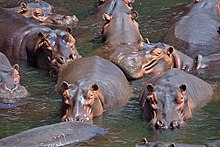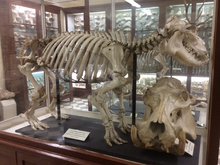Hippopotamidae
- This is the article on the family Hippopotamidae; for the main article on hippos, see Hippopotamus
| Hippopotamidae Temporal range: Middle Miocene-Present
| |
|---|---|

| |
| Common hippopotamus | |

| |
| Pygmy hippopotamus | |
| Scientific classification | |
| Kingdom: | Animalia |
| Phylum: | Chordata |
| Class: | Mammalia |
| Order: | Artiodactyla |
| Suborder: | Whippomorpha |
| Superfamily: | Hippopotamoidea |
| Family: | Hippopotamidae Gray, 1821 |
| Subtaxa | |
|
† Geze, 1985
| |
Hippopotamids are stout, naked-skinned, and semiaquatic artiodactyl mammals, possessing three-chambered stomachs and walking on four toes on each foot. While they resemble pigs physiologically, their closest living relatives are the cetaceans. Hippopotamids constitute the family Hippopotamidae.
There are two living species of hippopotamid in two genera; the pygmy hippo, Choeropsis liberiensis of the forests of west Africa, and the common hippo, Hippopotamus amphibius.
Characteristics[]
Hippopotamids are large mammals, with short, stumpy legs, and barrel-shaped bodies. They have large heads, with broad mouths, and nostrils placed at the top of their snouts. Like pigs, they have four toes, but unlike pigs, all of the toes are used in walking. Hippopotamids are unguligrade, although, unlike most other such animals, they have no hooves, instead using a pad of tough connective tissue on each foot. Their stomachs have three chambers, but they are not true ruminants.
The living species are smooth-skinned and lack both sebaceous glands and sweat glands. The outer epidermis is relatively thin, so hippos dehydrate rapidly in dry environments.[2]
Both the incisors and canines are large and tusk-like, although the canine tusks are by far the larger. The tusks grow throughout life. The postcanine teeth are large and complex, suited for chewing the plant matter that comprises their diets. The number of incisors varies even within the same species, but the general dental formula is given in the table below:
| Dentition |
|---|
| 2–3.1.4.3 |
| 1–3.1.4.3 |
Evolution[]

The hippopotamids are descended from the anthracotheres, a family of semiaquatic and terrestrial artiodactyls that appeared in the late Eocene, and are thought to have resembled small- or narrow-headed hippos. The hippos split off from the anthracotheres some time during the Miocene. After the appearance of the hippopotamids, the remaining anthracotheres went into a decline brought about by a combination of climatic change and competition with their descendants, until the last genus, Merycopotamus, died out in the early Pliocene of India.
There were once many species of hippopotamid, but only two survive today: Hippopotamus amphibius, and Choeropsis liberiensis. They are the last survivors of two major evolutionary lineages, the hippos proper and the pygmy hippos, respectively; these lineages could arguably be considered subfamilies, but their relationship to each other – apart from being fairly distant relatives – is not well resolved.
The enigmatic Miocene Kenyapotamus is insufficiently known to be assigned a place in the hippo phylogeny with any degree of certainty. In addition, the genus Hexaprotodon, in a sense now restricted to an extinct group of animals once living around the northern and northeastern Indian Ocean, which formerly included most ancient hippos, has turned out to be paraphyletic.
Taxonomy[]
Hippopotamidae's placement within Artiodactyla can be represented in the following cladogram:[3][4][5][6][7]
| Artiodactyla |
| ||||||||||||||||||||||||
Analogous structures[]
The lower canine teeth of hippopotamids are similar in function and structure to the tusks of elephants. While hippopotamids and elephants are only very distantly related within the Mammalia, the lower canine teeth of both groups are long and have a slight curve, and species of both families use this structure when fighting.
Species[]
The systematics and taxonomy used here mostly follows the review of Boisserie (2005) and the American Society of Mammalogists.[8][9]
Recent species[]
- Genus Hippopotamus – true hippopotamuses
- Hippopotamus amphibius – hippopotamus (Africa)
- †Hippopotamus lemerlei – Lemerle's dwarf hippopotamus (Madagascar; Holocene)
- †Hippopotamus madagascariensis – Madagascan dwarf hippopotamus (Madagascar; Holocene)
- Genus Choeropsis – pygmy hippopotamuses
- Choeropsis liberiensis – pygmy hippopotamus (west Africa)
Fossil species[]
- Genus Hippopotamus – true hippopotamuses
- †Hippopotamus antiquus – mainland Europe & British Isles; Pleistocene
- †Hippopotamus creutzburgi – Crete; Pleistocene
- †Hippopotamus minor – Cyprus; Pleistocene to Holocene
- †Hippopotamus melitensis – Malta; Pleistocene
- †Hippopotamus pentlandi – Sicily; Pleistocene
- †Hippopotamus laloumena – Madagascar; Holocene
- †Hippopotamus gorgops – Africa and mainland Europe; Late Miocene–Middle Pleistocene
- Tentatively placed into Hippopotamus:
- † – Kenya & Ethiopia; Pliocene -Pleistocene
- † – formerly genus Trilobophorus
- †Hippopotamus behemoth – Israel, Early Pleistocene
- † – Central Africa; Pliocene
- †Hippopotamus sirensis – Morocco & Algeria; Pleistocene
- Genus Hexaprotodon – hexaprotodons or Asian hippopotamuses
- † – Ethiopia; Pliocene
- † – Ethiopia; Pliocene
- † – Spain; Late Miocene (syn. Hexaprotodon primaevus)
- † – Algeria
- † – Uganda and Congo; Pliocene
- † – Myanmar; Pliocene – Pleistocene
- † – Kenya and Eritrea; Pleistocene
- † – India; (possibly same as Hex. palaeindicus)
- † – India;
- † – Italy; Pliocene
- † – Kenya and Chad; Pliocene
- † –
- † – Indonesia
- †Hexaprotodon sivalensis – India
- †Hexaprotodon sp. (undescribed) – Myanmar
- Genus Archaeopotamus – formerly included in Hexaprotodon
- †Archaeopotamus harvardi – Arabian Peninsula and Central Africa; Miocene – Pliocene
- †Archaeopotamus lothagamensis – Kenya; Miocene
- One or two undescribed species
- Genus Saotherium – formerly included in Hexaprotodon
- † Chad; Pliocene
References and notes[]
- ^ "Fossilworks: Hippopotamidae". fossilworks.org. Retrieved 17 December 2021.
- ^ Laws, Richard (1984). Macdonald, D. (ed.). The Encyclopedia of Mammals. New York: Facts on File. pp. 506–511. ISBN 0-87196-871-1.
- ^ Beck, N.R. (2006). "A higher-level MRP supertree of placental mammals". BMC Evol Biol. 6: 93. doi:10.1186/1471-2148-6-93. PMC 1654192. PMID 17101039.
- ^ O'Leary, M.A.; Bloch, J.I.; Flynn, J.J.; Gaudin, T.J.; Giallombardo, A.; Giannini, N.P.; Goldberg, S.L.; Kraatz, B.P.; Luo, Z.-X.; Meng, J.; Ni, X.; Novacek, M.J.; Perini, F.A.; Randall, Z.S.; Rougier, G.W.; Sargis, E.J.; Silcox, M.T.; Simmons, N.B.; Spaulding, M.; Velazco, P.M.; Weksler, M.; Wible, J.R.; Cirranello, A.L. (2013). "The Placental Mammal Ancestor and the Post-K-Pg Radiation of Placentals". Science. 339 (6120): 662–667. Bibcode:2013Sci...339..662O. doi:10.1126/science.1229237. hdl:11336/7302. PMID 23393258. S2CID 206544776.
- ^ Song, S.; Liu, L.; Edwards, S.V.; Wu, S. (2012). "Resolving conflict in eutherian mammal phylogeny using phylogenomics and the multispecies coalescent model". Proceedings of the National Academy of Sciences. 109 (37): 14942–14947. Bibcode:2012PNAS..10914942S. doi:10.1073/pnas.1211733109. PMC 3443116. PMID 22930817.
- ^ dos Reis, M.; Inoue, J.; Hasegawa, M.; Asher, R.J.; Donoghue, P.C.J.; Yang, Z. (2012). "Phylogenomic datasets provide both precision and accuracy in estimating the timescale of placental mammal phylogeny". Proceedings of the Royal Society B: Biological Sciences. 279 (1742): 3491–3500. doi:10.1098/rspb.2012.0683. PMC 3396900. PMID 22628470.
- ^ Upham, N.S.; Esselstyn, J.A.; Jetz, W. (2019). "Inferring the mammal tree: Species-level sets of phylogenies for questions in ecology, evolution, and conservation". PLOS Biology. 17 (12): e3000494. doi:10.1371/journal.pbio.3000494. PMC 6892540. PMID 31800571.(see e.g. Fig S10)
- ^ Boisserie identified the species Hippopotamus minor as Phanourios minutus, but this genus is not widely recognized.
- ^ Mammal Diversity Database (10 August 2021), Mammal Diversity Database, doi:10.5281/zenodo.5175993, retrieved 28 August 2021
Further reading[]
- Boisserie, Jean-Renaud (2005): The phylogeny and taxonomy of Hippopotamidae (Mammalia: Artiodactyla): a review based on morphology and cladistic analysis. Zool. J. Linn. Soc. 143(1): 1–26. doi:10.1111/j.1096-3642.2004.00138.x (HTML abstract)
- "Hippopotamidae". Integrated Taxonomic Information System. Retrieved 11 August 2004.
- Petronio, C. (1995): Note on the taxonomy of Pleistocene hippopotamuses. Ibex 3: 53–55. PDF fulltext
- Hippopotamuses
- Even-toed ungulates
- Mammal families
- Langhian first appearances
- Extant Miocene first appearances
- Taxa named by John Edward Gray